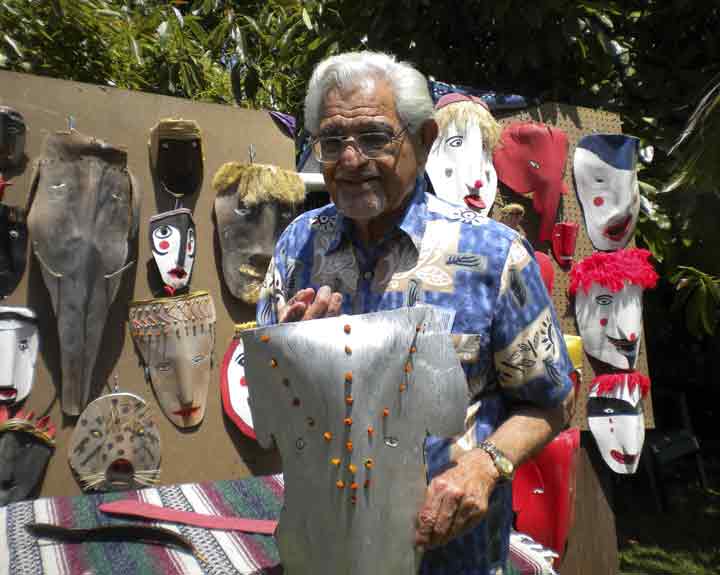
|
Masks by Albino Pineda run the gamut from human to animal - whatever the shape of the palm frond inspires him to create. |
Albino Pineda: Palm fronds as folk art centered on unique masks
June 20, 2012
By Peggy Kelly
Santa Paula News
About 18 months ago when Albino Pineda was trimming palm trees on his Santa Paula property, he was suddenly struck by the texture of the frond; and then he saw a nose, followed by eyes and other features of man or beast. That moment “became an instant career,” and turned Pineda into an artist whose primary medium is palm fronds used to create masks, including those that are brightly decorated with other accessories mostly provided by nature.
Pineda is no stranger to art: he was the originator/founder of the Railroad Plaza Farm Worker Monument, the only such memorial in the nation. A recipient of the Latino Town Hall Ray Garcia Humanitarian Award, Pineda (a World War II veteran) was commander of the Mercer-Prieto VFW Post 2043, and served several terms on the Santa Paula Elementary School District’s Board of Trustees.
An Arizona native, Pineda wrote “Among the Repatriated,” which highlights the impact on his family of the forced migration of perhaps one million people of Mexican descent - including many U.S. citizens - during the Great Depression.
Now he is an artist: Pineda unveiled his masks for family and friends at the annual barbeque he and his wife Lydia host, this year not only featuring a fine meal, but also fine folk art - dozens of his creations displayed for all to see. Masks - ranging from elephants and cats to those resembling Jesus and Cleopatra - are the results of Pineda’s hacksaw, “My best tool,” and drill, woodcarving tools and sandpaper.
Actually Pineda’s best tool is his imagination: Some masks sport hair made of corn silk or twine, clever bottle cap teeth, seeds for eyes, and layered cuttings from the frond itself for special touches, among other materials he incorporates into his art.
Pineda does probably one a day, sometimes two, and fronds that don’t inspire his love of faces are left in their natural shape but painted with bright flowers against colored backgrounds, sometimes dusted with a sprinkling of glitter that that catches the light of the sun as the fronds move in the breeze.
“I start with the frond and then get a vision of the work... some are contorted so I’ll make a contorted face. Cleopatra is my personal favorite,” the Queen of the Nile requiring earrings and other accessories.
Pineda started collecting masks in the mid-1990s after his daughter brought him one back from Japan. Now he has an entire room filled with masks he collected, including those gifted by his good friend Steve Turchik.
“I like the expressions you can make with masks” that require carving, painting and the addition of accessories. “Fronds are like canvas, they’re not absorbent at all,” and those that are painted are done both with acrylics or watercolor.
For some masks, Pineda takes advantage of the natural frond material and does little decorating. He has created more than 40 pieces of varying sizes, from a yellow leopard and African tribesman to the devil, clowns, and a Mardi Gras type mask.
In reply to a question, Pineda said, “What do I like most about it? The fun of it! I never thought I’d be doing this.” And that includes portraits of sorts: “Sometimes I see a picture in the newspaper and I try to emulate the face.”
Aside from the features, the expressions, and the creative process, Pineda said he was also attracted to the fronds and their possibility of a unique art form because, “It looked easy to do!”



